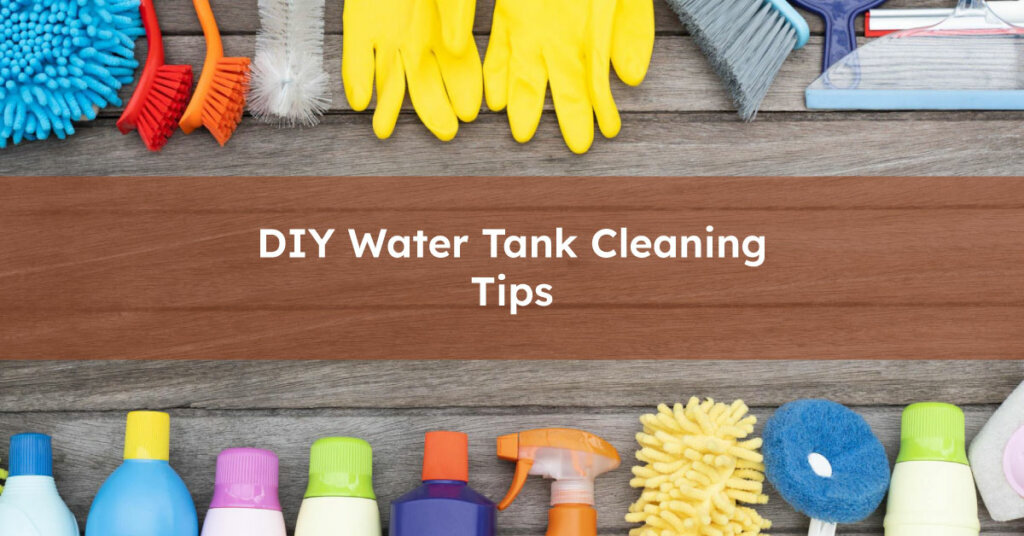Keeping your water tank clean is essential for the health and safety of your household. Regular maintenance and cleaning are crucial to prevent the buildup of sediment, sludge, and bacteria, ensuring that you have access to clean and safe water at home.

In this article, we will provide you with DIY water tank cleaning tips that you can easily follow to keep your water tank pristine. It’s time to take control of your water quality and ensure the wellbeing of your family.
Table of Contents
Key Takeaways
- Regular water tank cleaning is essential to maintain clean and safe drinking water at home.
- DIY water tank cleaning can be done using simple tools and materials.
- The cleaning process involves draining the tank, removing sediment and sludge, scrubbing the interior surfaces, rinsing, disinfecting, and refilling.
- Proper safety precautions, including wearing protective gear, should be taken before starting the cleaning process.
- By following these DIY water tank cleaning tips, you can ensure the long-term maintenance and cleanliness of your water tank.
Preparing for DIY Water Tank Cleaning
Before you begin cleaning your water tank, it is important to prioritize safety. This involves wearing appropriate protective gear such as gloves, goggles, and a face mask to guard against potential contaminants. Additionally, ensure proper ventilation in the area to prevent inhaling fumes.
Safety First: Protective Gear and Precautions
Prioritizing safety is crucial when it comes to water tank cleaning. Follow these safety precautions to ensure a safe cleaning process:
- Wear gloves, goggles, and a face mask to protect yourself from potential contaminants.
- Ensure proper ventilation in the area where you will be cleaning to prevent inhaling fumes.
Tools and Materials You Will Need
Gather the necessary tools and materials for a successful DIY water tank cleaning:
- Submersible pump: Used to drain the water tank efficiently.
- Hose: Helps to facilitate draining and rinsing the tank.
- Scrub brush: Ideal for scrubbing the interior surfaces of the water tank.
- Bucket: Used for collecting sludge or sediment removed from the tank.
- Cleaning agent: Vinegar or hydrogen peroxide can be effective for removing stubborn stains and bacteria.
- Disinfectant solution: Essential for disinfecting the water tank after cleaning.
By taking the necessary safety precautions and gathering the right tools and materials, you’ll be well-prepared to clean your water tank effectively.
Step-by-Step Guide to Cleaning Your Water Tank
In order to maintain the cleanliness and safety of your water tank, it is important to follow a step-by-step cleaning process. By following these instructions, you can ensure that your water tank is thoroughly cleaned and free from contaminants.
Draining the Tank
The first step in cleaning your water tank is to completely drain it. This can be done by using a submersible pump or a hose to remove all the water from the tank. Ensure that you direct the water away from any plants or sensitive areas to prevent any damage.
Removing Sludge and Sediment
Once the tank is drained, it’s time to remove any accumulated sludge and sediment. Use a scrub brush to scrub the bottom of the tank and loosen any debris. Carefully remove the sludge and sediment with a bucket or a vacuum. Dispose of it properly according to local regulations.
Scrubbing the Interior Surfaces
After removing the sludge and sediment, it’s important to scrub the interior surfaces of the tank. Use a scrub brush and a suitable cleaning agent such as vinegar or hydrogen peroxide to thoroughly clean the walls and floor. Pay special attention to any stubborn stains or areas of buildup.
Rinsing the Tank
Once you have scrubbed the tank, rinse it thoroughly with clean water. Use a hose or buckets of water to flush out any remaining debris or cleaning solution. Make sure that the water runs clear and there are no traces of cleaning agents left in the tank.
Disinfecting the Tank
After rinsing, it is crucial to disinfect the tank to kill any remaining bacteria or pathogens. Prepare a disinfectant solution using a suitable product recommended for water tank cleaning. Follow the instructions on the product and make sure to distribute the disinfectant evenly throughout the tank. Leave the disinfectant in the tank for the recommended amount of time to ensure effectiveness.
Final Rinsing and Refilling
Once the tank has been disinfected, give it a final rinse with clean water to remove any residual disinfectant. Make sure to flush out all the disinfectant solution thoroughly. Finally, refill the tank with fresh, clean water from a safe source. Ensure that the water meets the necessary quality standards before using it for drinking or other purposes.
| Step | Description |
|---|---|
| Draining the Tank | Use a submersible pump or hose to completely drain the water tank. |
| Removing Sludge and Sediment | Scrub the tank’s interior and remove any accumulated sludge and sediment. |
| Scrubbing the Interior Surfaces | Use a scrub brush and cleaning agent to thoroughly clean the tank’s walls and floor. |
| Rinsing the Tank | Flush the tank with clean water to remove debris and cleaning agents. |
| Disinfecting the Tank | Prepare and distribute a suitable disinfectant solution throughout the tank. |
| Final Rinsing and Refilling | Rinse the tank with clean water and refill it with fresh water from a safe source. |
Conclusion
Regularly cleaning your water tank is crucial for maintaining the quality of your drinking water. It’s not just about removing accumulated contaminants, but also preventing the growth of bacteria and algae. By following these DIY water tank cleaning tips, you can ensure that your water tank remains clean and safe.
Remember, maintaining a clean water tank is an ongoing process. It’s important to conduct regular inspections and cleaning to keep your drinking water free from any potential health hazards. We hope this article has provided you with valuable insights and useful tips for DIY water tank cleaning. For more detailed information specific to Dubai, check out our comprehensive guide to water tank cleaning in Dubai.
FAQ
What is the best way to remove sediment from the bottom of the tank?
The most effective way to remove sediment from the bottom of your water tank is by using a wet vacuum or manually scooping it out after draining the tank. For tanks that can’t be entered, a high-pressure hose can help loosen and remove sediment through the drainage outlet. Regularly removing sediment prevents the accumulation of harmful bacteria and extends the life of your tank.
How can I ensure all areas of the tank are thoroughly cleaned?
To ensure all areas of the tank are thoroughly cleaned, use a long-handled brush or high-pressure hose to scrub and rinse every surface, including hard-to-reach corners and the tank roof. If possible, enter the tank to inspect and clean manually, ensuring you wear protective clothing and follow safety guidelines to prevent accidents.
What should I do after cleaning the tank to ensure the water is safe?
After cleaning the tank, it’s crucial to refill it with clean water and add the appropriate amount of a water purifier or disinfectant to eliminate any remaining bacteria or viruses. Test the water quality to ensure it meets safety standards before using it. Regular monitoring and maintenance after cleaning can help keep your water tank in optimal condition and your water safe for use.




